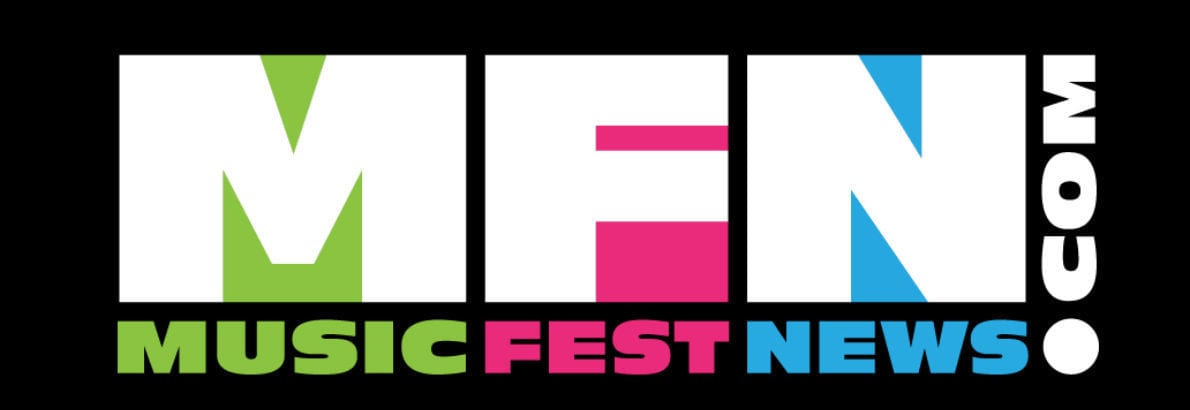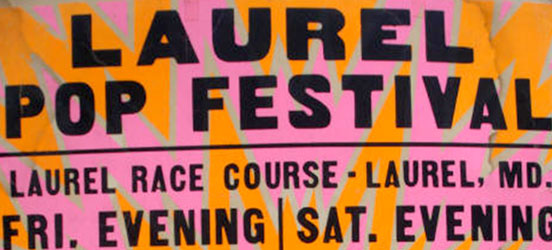
50 Years On: The Laurel Pop Festival
After an enormous positive change in my life, my second-ever music festival was Langerado in March of 2007. It was a revelation: Bela Fleck & the Flecktones, Trey Anastasio Band, the Disco Biscuits, Perpetual Groove, the Slip, and so many more. Number three was Wanee in April 2007, and that one was truly transformational. The floodgates were opened…
But what was the first festival, you ask? Well, you’d need to get into Mr. Peabody’s Way-Back Machine, back to the summer of 1969, when the scene was exploding. The Denver Pop Festival was the end of June, followed by Atlanta Pop Festival over the 4th and 5th of July. You can read Rick Davidson’s account of that one here.
Seattle Pop was later in July, then Atlantic City Pop at the beginning of August. And that famous one on Yasgur’s farm. Between Atlanta and Seattle, there was another:
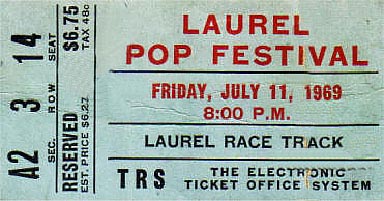
The Laurel Pop Festival. It was held at the Laurel Race Track in Maryland over two nights, July 11 and 12. We were beside ourselves to attend the Friday night show. In retrospect, I would have loved the second night just as much but knew far less about that lineup at the time.
So my high-school girlfriend Bonnie; my brother, Phil; his best friend Ted and I piled into my 1962 Corvair Station Wagon for the drive from Baltimore to Laurel. We arrived to discover rows upon rows of folding wooden chairs, and we found our seats.
Let’s talk about logistics first. There would be six bands playing, the business of set changes was brand new, and the program each evening didn’t begin until 8 p.m.! I suspect you can discern the problem.
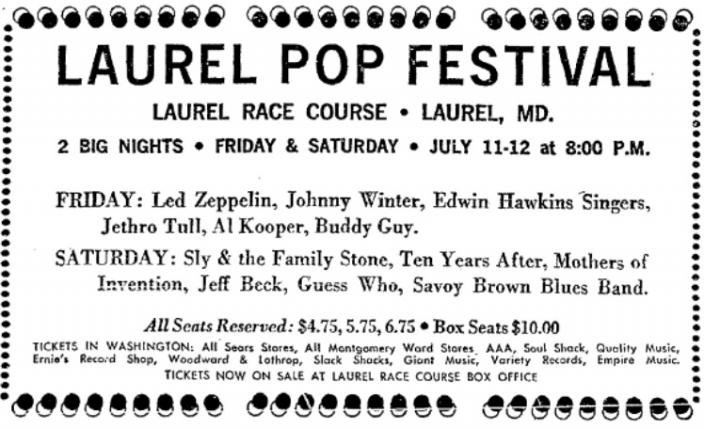
FRIDAY, JULY 11
We had no idea who Buddy Guy, not quite 33, was back then, but we were digging the blues and really liked his set. He was followed by the Edwin Hawkins Singers, a full gospel choir enjoying the success of their smash single “Oh Happy Day.” They were fresh and exciting.
We did know who Al Kooper was, given his brief tenure with Blood, Sweat and Tears; we hadn’t discovered the Blues Project yet. He came out with what seemed like a 20-piece orchestra, although it was probably more like 12. It was jazz, and we enjoyed it, but the thought of the headliners to come was distracting at best.
We had never heard of the next band on the bill. Heard they might be country rock. We certainly didn’t know that their second album, Stand Up, was topping the charts in England. I suspect that most people can still remember exactly what they saw when Jethro Tull hit the stage. Here was this guy, with a flute, in a bathrobe, picking his leg up and bending and pointing it like a dancer. Ian Anderson was a sight to behold, and the music was amazing. The band was killer.
At this point, we started looking at our watches and realizing that this was going to run very late. I don’t think any of us had discussed with parents when exactly we planned to be home, but it wasn’t way after midnight. Also, the set breaks seemed interminable. I have no way to judge how long they actually were, but it seemed like forever.
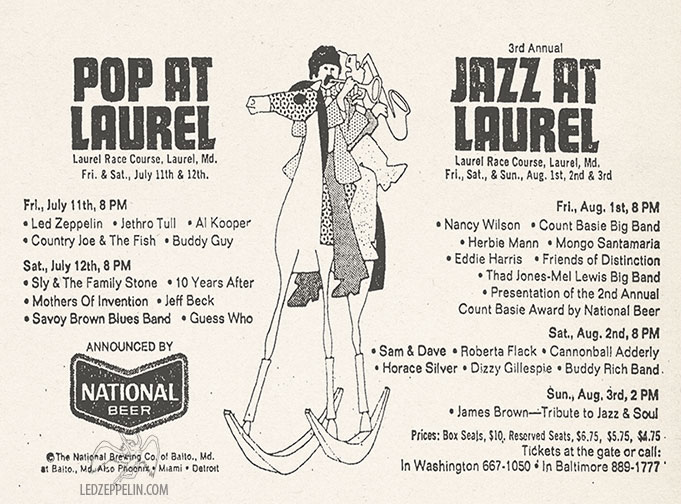
Except for Johnny Winter (billed as Johnny Winters). It felt like only 15 minutes or so, and he and the band were up and rockin’. Phil and I had latched onto The Progressive Blues Experiment about five months earlier and never let go. Winter was mesmerizing as he rolled and tumbled through the great set with Tommy Shannon on bass guitar and “Uncle” John Turner at the drum kit.
It took longer to get Led Zeppelin ready. Somehow, we had missed them six weeks earlier at Merriweather Post Pavilion opening for The Who. This was Zep’s first headlining U.S. tour. We were so totally ready — and also painfully aware that it was already 1 a.m.
They were incredible, everything we had hoped for. I’ve looked at various attempts at setlists from people, none of which quite mesh with mine. I swear that Jimmy Page grabbed an acoustic for “White Summer” at some point, but nobody else lists that. The Yardbirds’ kicker “The Train Kept A-Rollin’” was in there, too. We got “I Can’t Quit You Baby” and “Dazed and Confused” — didn’t Page have a violin bow?
Plant announced that they would play a song off the album to be released in the fall (Led Zep II), and we heard for the first time “What Is and What Should Never Be.” “You Shook Me” did exactly that. Now I also swear that in the middle of that song (or was it another?), as I had my arm around Bonnie, the band went into a more subdued section as Plant crooned, “Squeeze my lemon, ’til the juice runs down my leg.” Alrighty then!
After a stunning “How Many More Times,” with the clock now past 2 a.m., they broke into “Communication Breakdown.” Also around that time, the authorities decided to pull the plug — literally. All we could hear was John Bonham pounding away on the drums and Plant wailing like a banshee. Communication breakdown indeed!
Man, were we ever late getting home!
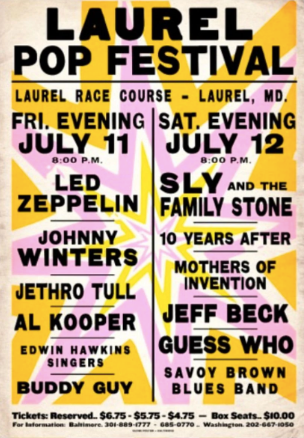
SATURDAY, JULY 12
Even if we’d had tickets for Saturday, none of us would have been allowed to go due to the absurdly late time we rolled home Friday. Unlike the clear skies and beautiful night Friday, Saturday was miserable. It was pouring. There was no cover anywhere, and music was delayed for two hours. The opening band, the Savoy Brown Blues Band, was held until later but never did play that night.
The rest of this comes from various reports. I am glad to say that I got to hear all six of these groups perform by 1972.
The Jeff Beck Group featured vocals from Extraordinaire Rod Stewart, followed by The Guess Who, riding the charts with “These Eyes” (they hadn’t busted out “Undun” yet). And the Mothers of Invention apparently kept it pretty inside, garnering great musical reviews, although I’m sure that hilarity ensued nonetheless.
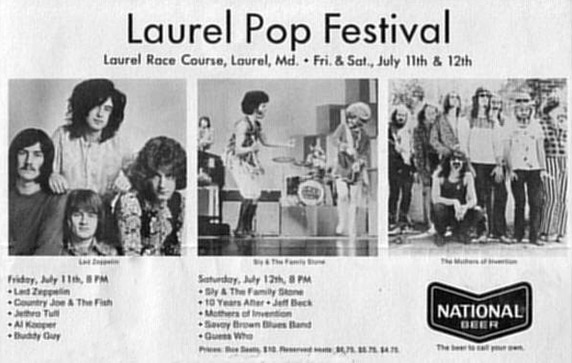
Ten Years After, poised for Woodstock stardom, had the penultimate set, followed — starting at 2 a.m. — by Sly and the Family Stone, who would make a Woodstock splash of their own. And Sly was on time! They apparently knocked it out of the race course.
But it was cold. And miserable. And many people had left. So some in the crowd warmed themselves with a campfire of wooden chairs.
That did it. There was never another Laurel Pop Festival. Most of those festivals never had a round two, in fact. But, for two fascinating nights, Laurel, Maryland, was on the national festival map.
